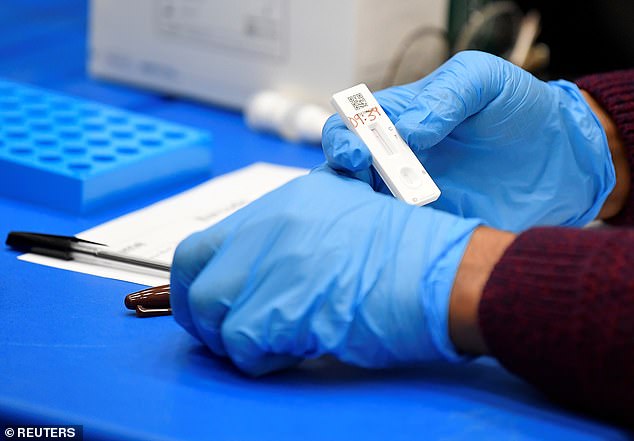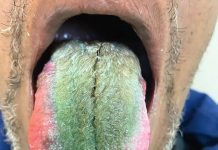Lateral flow tests are better at spotting people at greater risk of spreading Covid and are more accurate than previously thought, a study has claimed.
British and US researchers found rapid tests are 90 per cent effective at detecting the virus in people who are at their most infectious.
And the swabs — which have been criticised for both missing cases and producing false positives, especially when self-administered — are up to 80 per cent effective at finding Covid in all people, the study found.
Lateral flows are the standard tests used in schools across Britain and are free on the NHS for people who have no symptoms.
Previous research has suggested the tests — which can give results in as little as 15 minutes — miss as many as 42 per cent of asymptomatic people and 22 per cent of symptomatic cases.
But most other studies compare lateral flow results to infections confirmed by a lab-based PCR test, which is ‘like comparing apples and oranges’, according to the researchers.
Instead they used a mathematical formula to recalibrate previous data to reflect the fact that lateral flows are designed to detect people who are actively infectious, not diagnose any infection, as is the case for PCRs.

Lateral flow tests are better at detecting people at greater risk of spreading Covid and are more accurate than previously thought, a study has claimed
WHAT HAS PREVIOUS RESEARCH SAID ABOUT COVID LATERAL FLOW TESTS’ ACCURACY?
Rapid coronavirus tests may miss four in 10 asymptomatic people, a major review concluded earlier on in the pandemic.
Researchers who analysed 64 studies of the effectiveness of lateral flow kits found they failed to detect 42 per cent of cases who didn’t show signs of illness.
The gold-standard Cochrane review found the tests, which give results in as little as 30 minutes, were better at catching symptomatic cases (78 per cent).
The findings have caused concern among some scientists because it’s thought that at least half of Covid transmission comes from patients who seem well.
Children are even less likely to fall ill with coronavirus but can still act as spreaders of the disease.
Hundreds of thousands of lateral flow tests are being used each day on teachers and pupils in a bid to keep schools open and Covid-free. They are also deployed in care homes, hospitals, and across businesses.
Professor Jon Deeks, a biostatistician at Birmingham University and co-author of the report, said ministers may have rushed lateral flow tests out in schools ‘without any supporting real-world evidence’.
The review also found lateral flow tests were prone to giving false positives, when a test says someone is infected but they aren’t.
Advertisement
Lead author Professor Irene Petersen, an epidemiologist at University College London, said using PCR tests as a ‘gold standard’ when comparing to lateral flows makes little sense.
She said: ‘Previous studies comparing the reliability of lateral flow tests and PCR tests could be potentially misleading because a PCR test is a marker of having been infected at some point within a certain window of time and does not necessarily mean someone is infectious when testing positive.
‘In most validation studies, individuals were tested simultaneously with LFTs and PCR tests, with PCRs being used as a gold standard to say someone is “positive or negative”.
‘The sensitivity of the LFTs was therefore evaluated by their ability to identify the same cases that the PCRs picked up.
‘However, this is like comparing apples and oranges.’
Researchers reviewed the data on how long people are infectious and used that to derive the formula to recalibrate testing efficacy data.
They estimated that of the group who tested positive on a PCR but were asymptomatic and missed by lateral flows, only half would have been infectious.
Therefore previous studies estimating lateral flows were less than 50 per cent effective at detecting Covid likely underestimated their effectiveness significantly, the researchers said.
Professor Michael Mina, an epidemiologist at Harvard University, said: ‘There is a spectrum of infectious amounts of the Covid virus and we show that LFTs are likely to detect cases 90 to 95 per cent of the time when people are at their most infectious.
‘The tests could achieve even 100 per cent sensitivity when viral loads are at their peak and therefore catch nearly everyone who is currently a serious risk to public health.
‘It is most likely that if someone’s LFT is negative but their PCR is positive then this is because they are not at peak transmissible stage.’
Professor Petersen added: ‘As LFTs are becoming widely used in schools, workplaces and for admittance to venues such as those used for large events, it is important that health professionals and the public have clear information about the operating characteristics of the tests.
‘We have demonstrated that the absolute sensitivity to detect SARS-CoV-2 antigens is likely high with LFTs.
‘To improve our understanding of their characteristics, longitudinal studies where individuals, and ideally contacts of cases, are tested daily by LFTs and PCR tests would help to further understand false negatives (and false positives) and, importantly, the time differences of between turning PCR positive, LFT positive, and symptom onset.’
Source link : https://www.dailymail.co.uk/news/article-10092015/Lateral-flow-tests-detect-people-greater-risk-spreading-Covid-study-claims.html











